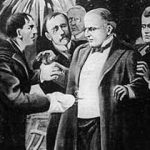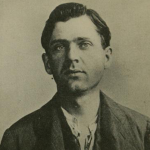death sentence
 When we think of vaccinations, most of us think of modern-day medicine, but that wasn’t always the case. There have been serious diseases out there for centuries, and in fact, since Biblical days. Many of those diseases have been cured these days, or they are at least manageable, but in the 1700s, a disease like Smallpox was deadly. Others like Leprosy were just as bad. I’m sure that any doctor in those days cringed at having to make a diagnosis like that, because he knew that he was pronouncing a death sentence on his patient, and basically all he could do was to tell them to get their affairs in order and go into hiding to die, because their case was one with no hope of survival.
When we think of vaccinations, most of us think of modern-day medicine, but that wasn’t always the case. There have been serious diseases out there for centuries, and in fact, since Biblical days. Many of those diseases have been cured these days, or they are at least manageable, but in the 1700s, a disease like Smallpox was deadly. Others like Leprosy were just as bad. I’m sure that any doctor in those days cringed at having to make a diagnosis like that, because he knew that he was pronouncing a death sentence on his patient, and basically all he could do was to tell them to get their affairs in order and go into hiding to die, because their case was one with no hope of survival.
Vaccinations, for any disease, start out as trial and error, and Smallpox was no exception to that rule, but Edward Jenner, while still a medical student noticed that milkmaids who had contracted a disease called cowpox, which caused blistering on cow’s udders, did not catch smallpox. Unlike smallpox, which caused severe skin eruptions and dangerous fevers in humans, cowpox led to few ill symptoms in these women. I guess it takes a  medically trained mind to connect the two situations and find whatever small similarity there is between the two diseases…and then decide to experiment with a possibility that no one else saw…or to decide not to.
medically trained mind to connect the two situations and find whatever small similarity there is between the two diseases…and then decide to experiment with a possibility that no one else saw…or to decide not to.
Jenner was that kind of a medical mind. By 1796, Jenner was an English country doctor, who hailed from Gloucestershire. On May 14, 1796, he took fluid from a cowpox blister and scratched it into the skin of James Phipps, an eight-year-old boy. A single blister rose up on the spot, but James soon recovered. On July 1, Jenner inoculated the boy again, this time with smallpox matter, and amazingly, no disease developed. The vaccine was a success. The medical world at the time, went wild. Doctors all over Europe soon adopted Jenner’s innovative technique, leading to a drastic decline in new sufferers of the devastating  disease, as well as many lives saved.
disease, as well as many lives saved.
Following Jenner’s model, scientists in the 19th and 20th centuries, scientists developed new vaccines to fight numerous deadly diseases, among them polio, whooping cough, measles, tetanus, yellow fever, typhus, and hepatitis B. The lists of vaccines, goes on and on, all using the same model. More sophisticated smallpox vaccines were also developed and by 1970 international vaccination programs, such as those undertaken by the World Health Organization, had eliminated smallpox worldwide. Many people, these days would question the World Health Organization, and its motives, but there was a time that vaccines were very helpful and saved a lot of lives. I think it is sad that politics has made its entrance into the world of vaccines, because the lack of trust we have now is making the World Health Organization more of a hindrance than a help.
 I find it very sad to think that if a person had some ailments or injuries in this day and age, they would likely have lived through the episode, but in days gone by, and for President McKinley, that was not to be the case.
I find it very sad to think that if a person had some ailments or injuries in this day and age, they would likely have lived through the episode, but in days gone by, and for President McKinley, that was not to be the case.
On September 6, 1901, while standing in a receiving line at the Pan-American Exposition in Buffalo, New York, McKinley was approached by Leon Czolgosz, a Polish-American anarchist carrying a concealed .32 revolver in a handkerchief. Czolgosz shot McKinley twice at close range. One bullet deflected off a suit button, but the other entered his stomach, passed through the kidneys, and lodged in his back. When he was operated on, doctors failed to find the bullet. That in and of itself was a very  serious situation, but I believe it would have been survivable. Unfortunately for President McKinley, the doctors of that time had few, if any antibiotics to fight infection, and gangrene soon spread throughout the president’s body. McKinley died eight days later, on September 14, 1901. Czolgosz was convicted is of murder and executed soon after the shooting.
serious situation, but I believe it would have been survivable. Unfortunately for President McKinley, the doctors of that time had few, if any antibiotics to fight infection, and gangrene soon spread throughout the president’s body. McKinley died eight days later, on September 14, 1901. Czolgosz was convicted is of murder and executed soon after the shooting.
These days, there have been a number of people who have had injuries far more grave than President McKinley had, and yet they have come through with flying colors. I think it is irrelevant what a person’s politics are or whether you think President McKinley was a good president or a bad president, because this really isn’t about politics at all. The reality is that this man died largely because of a lack of modern medicines that could  have easily cured the gangrene he had from the shooting, or in most cases, prevented it all together.
have easily cured the gangrene he had from the shooting, or in most cases, prevented it all together.
None of us likes to pay for the cost of some of the life-saving drugs that have been developed, but it is partly that cost that helps to pay for the research that goes into these new medicines. Whether we pay for them by donations before development or cost after development, really makes no difference. I know many people think that the drug companies gouge the patient, and I suppose that could be true to an extent, but which one of us has what it takes to find a medicine that cures some of the diseases we can cure today, that were a death sentence in years gone by?

